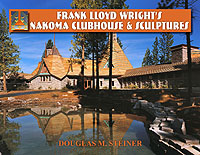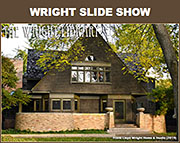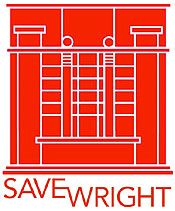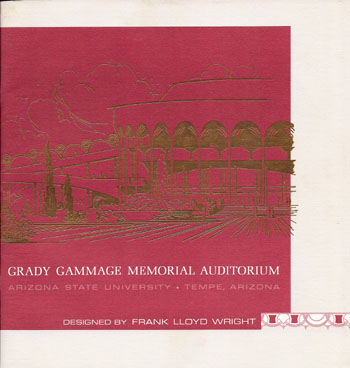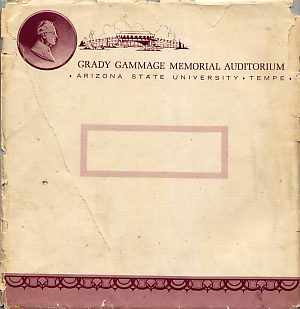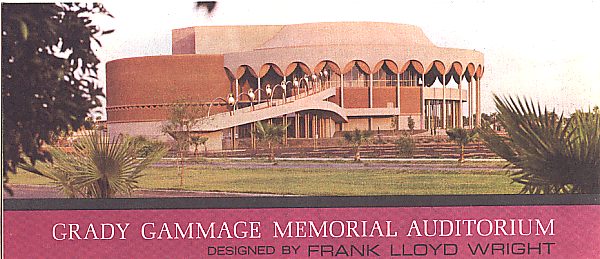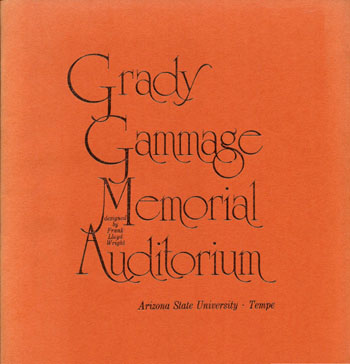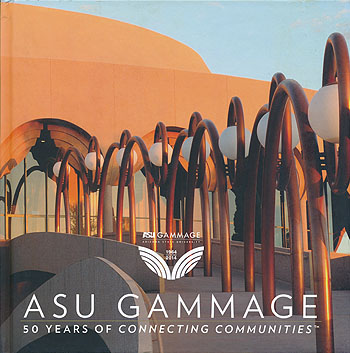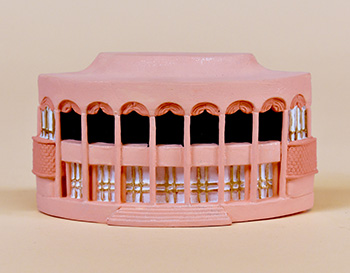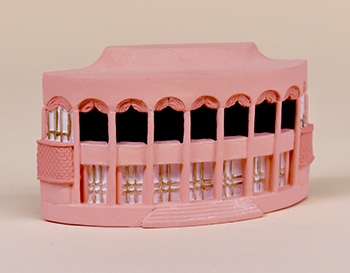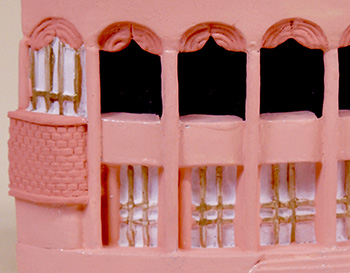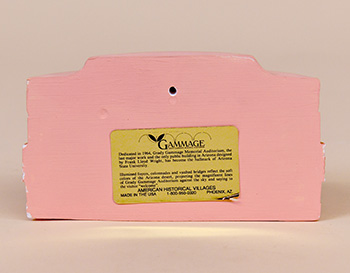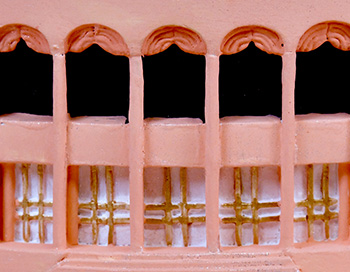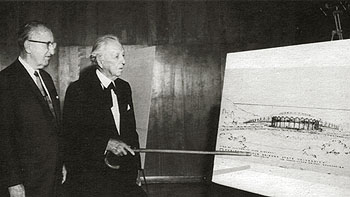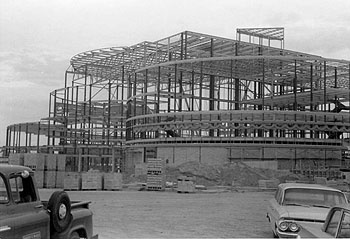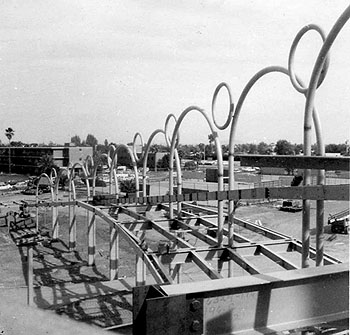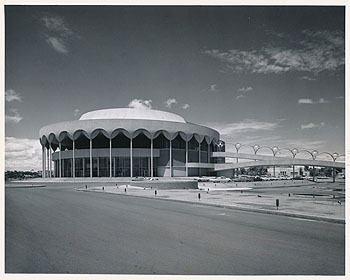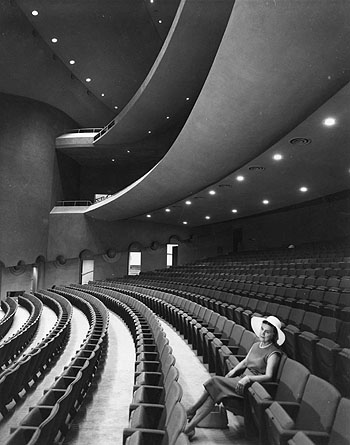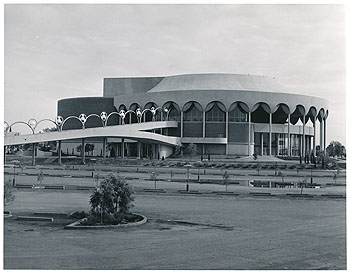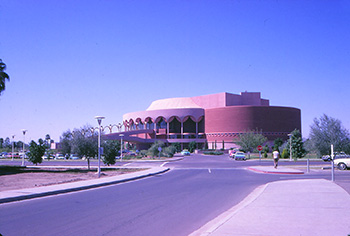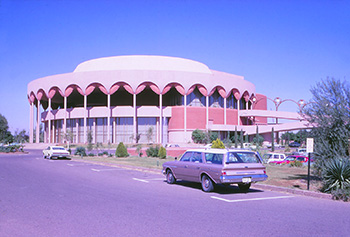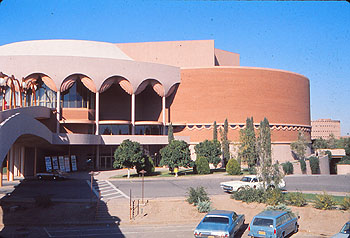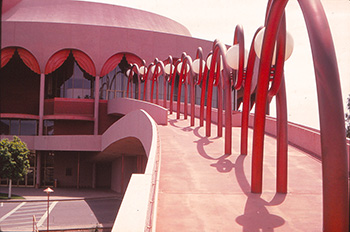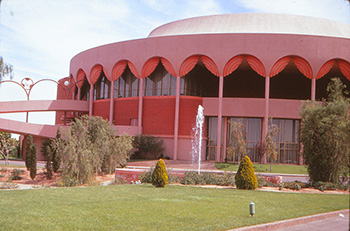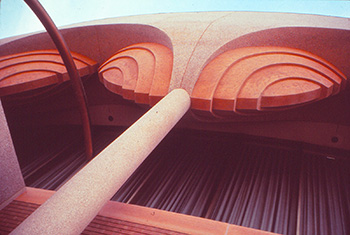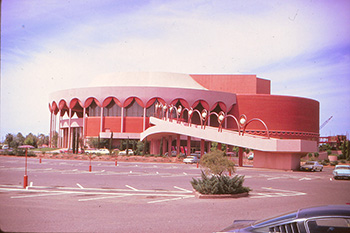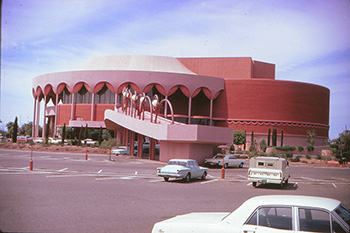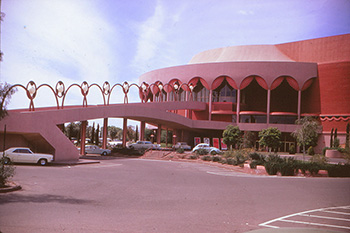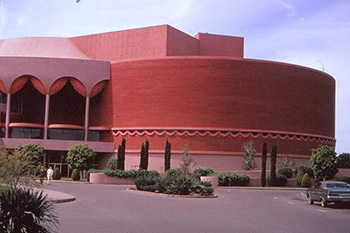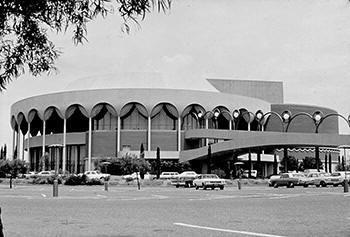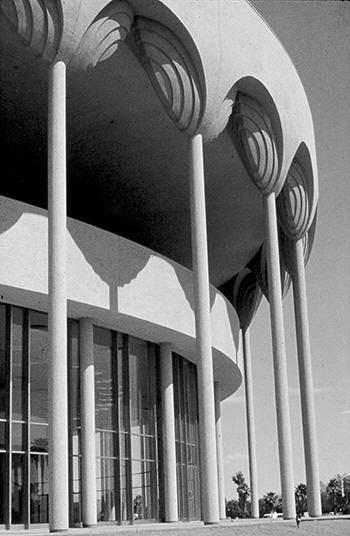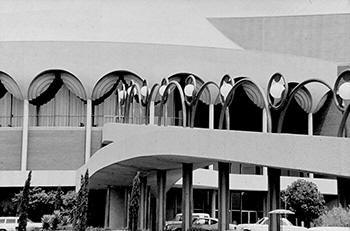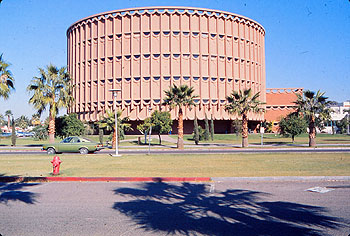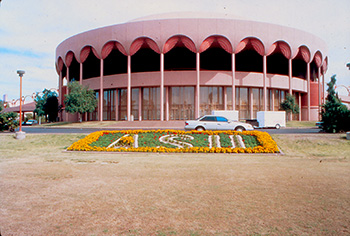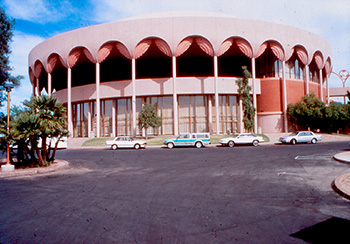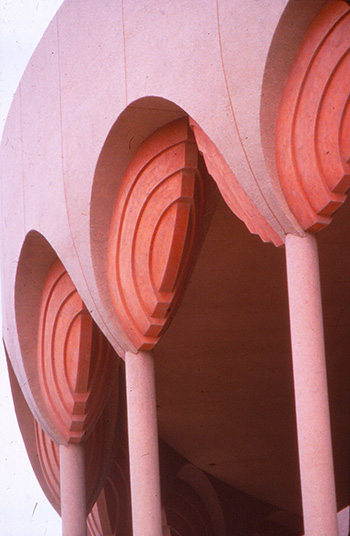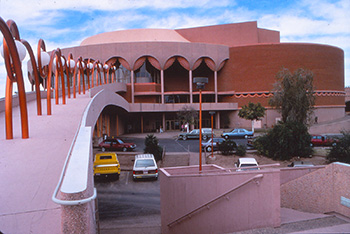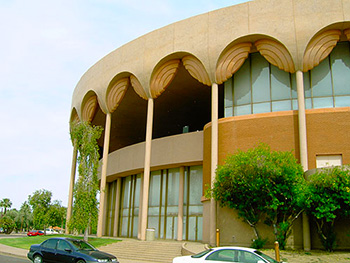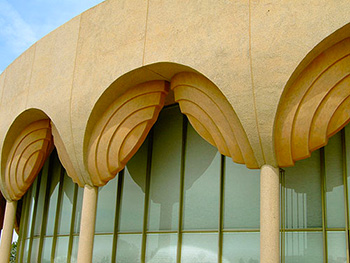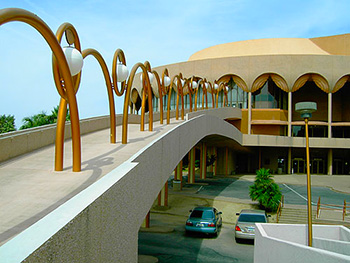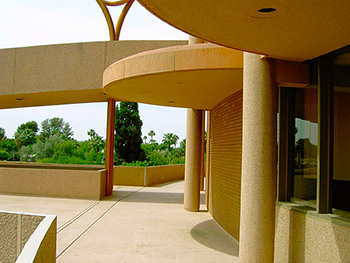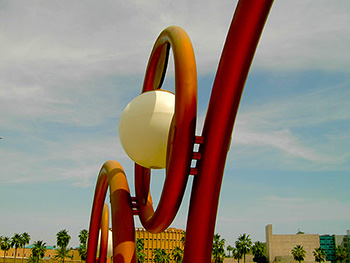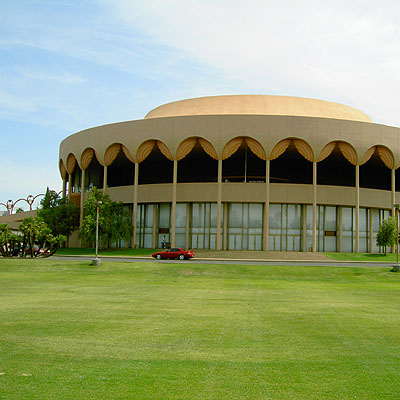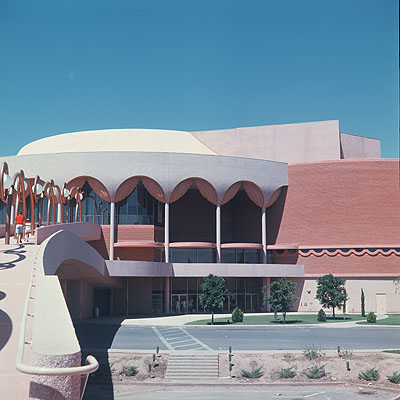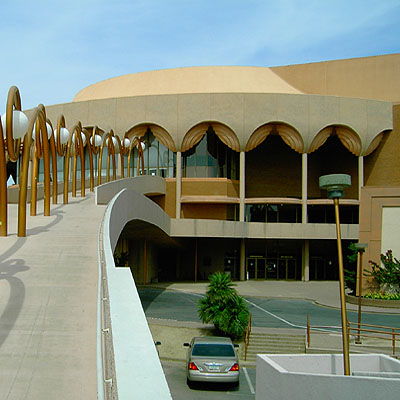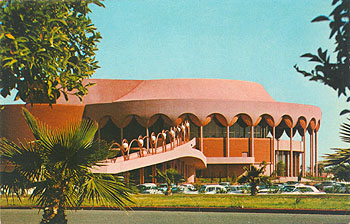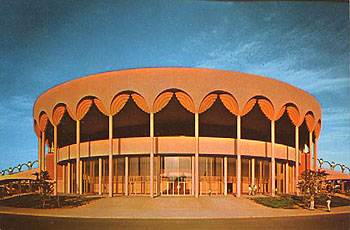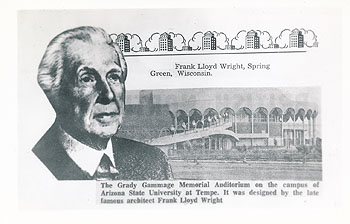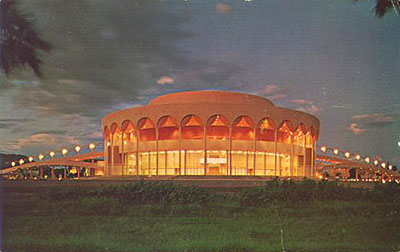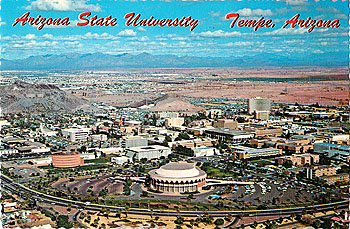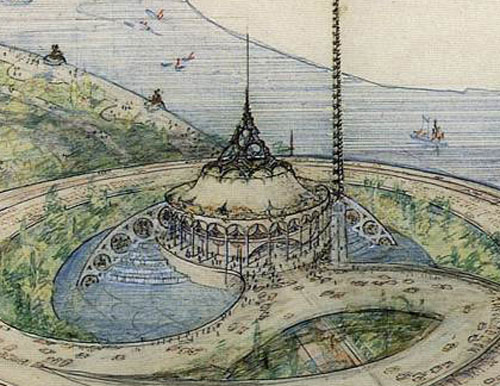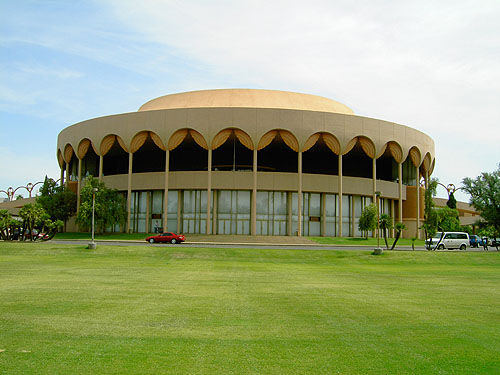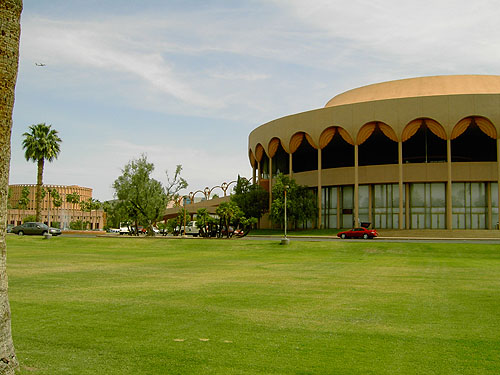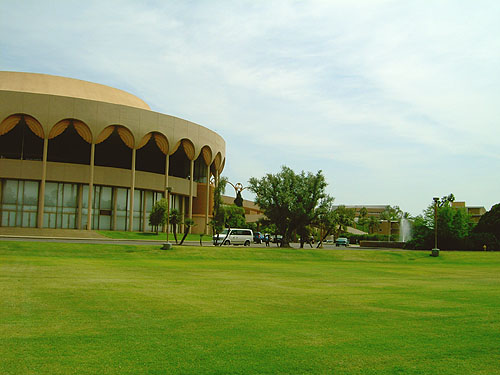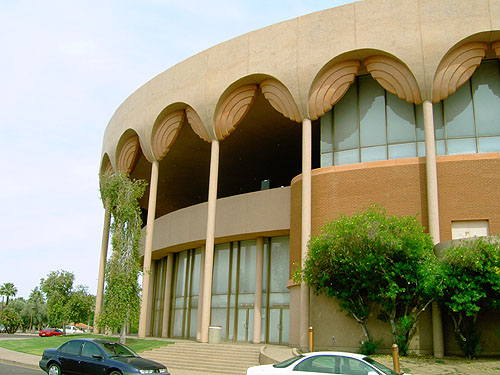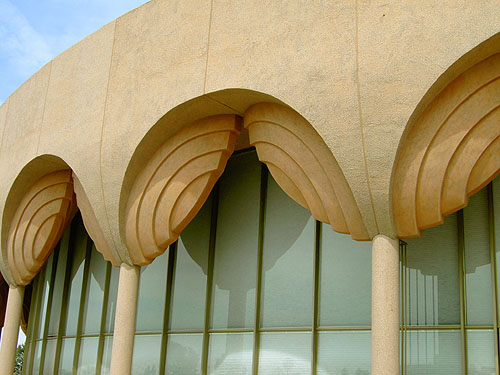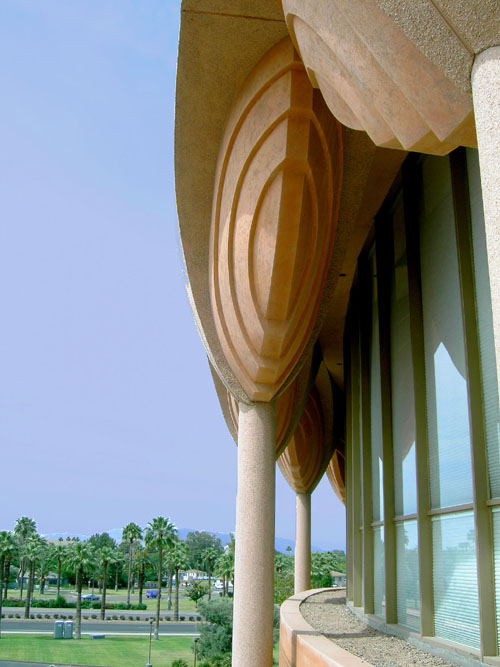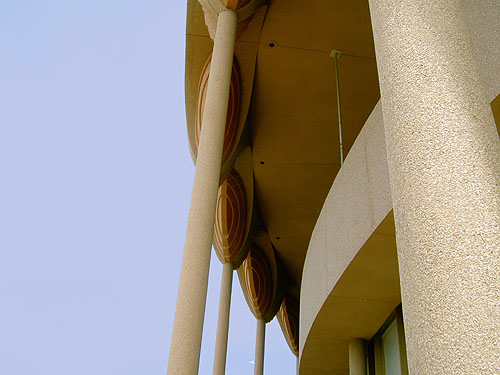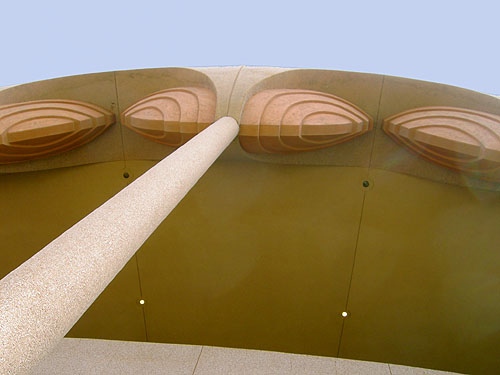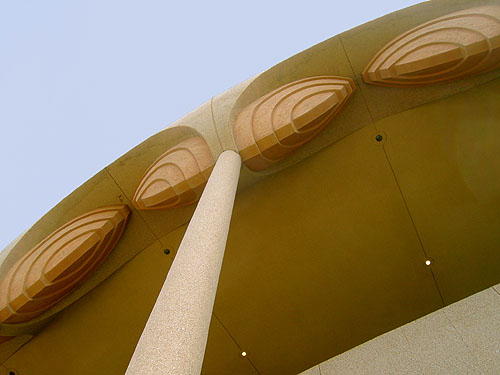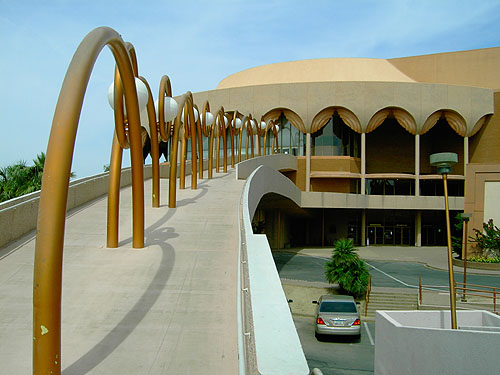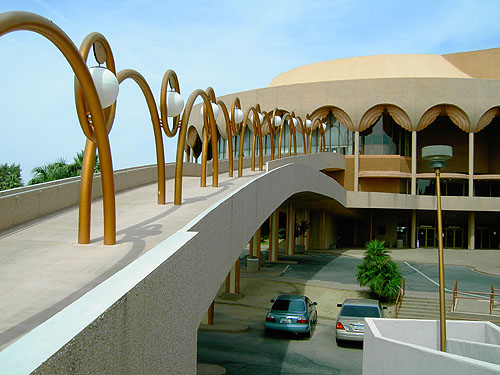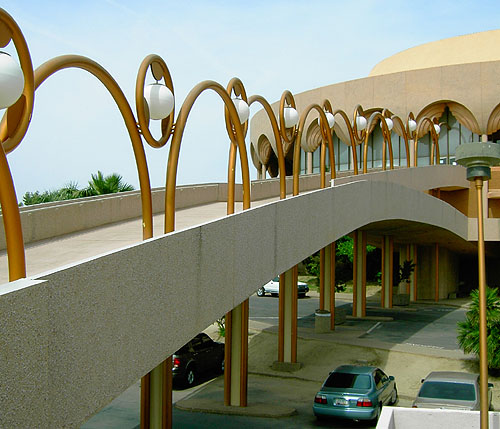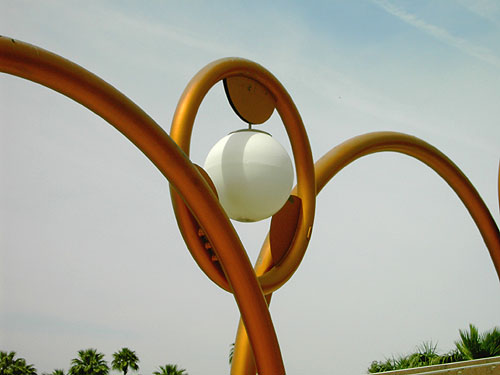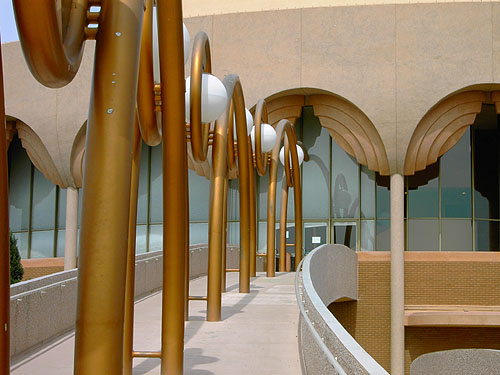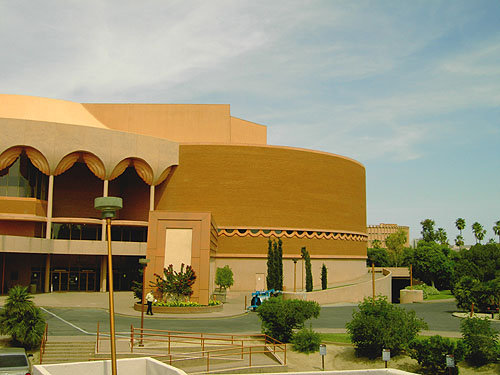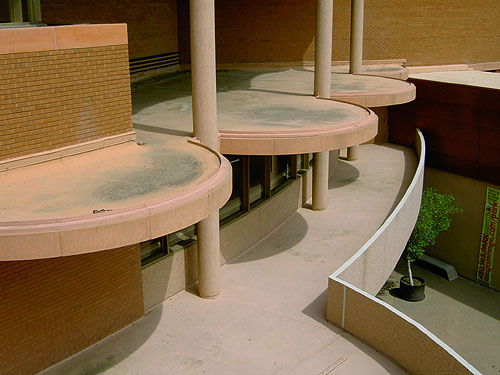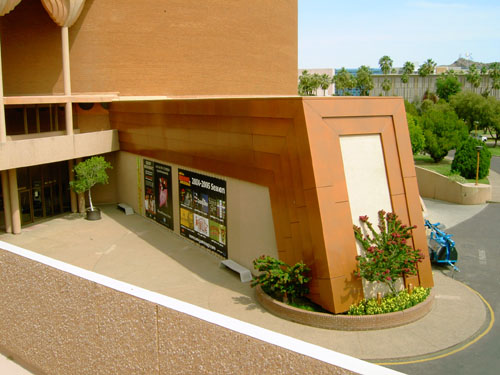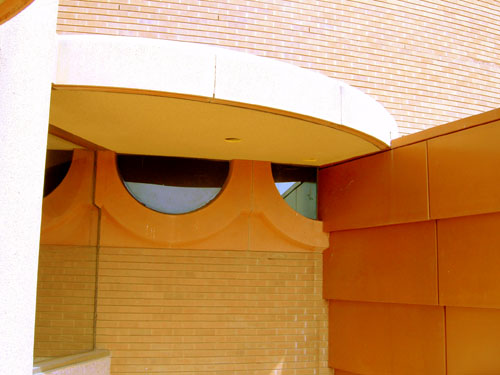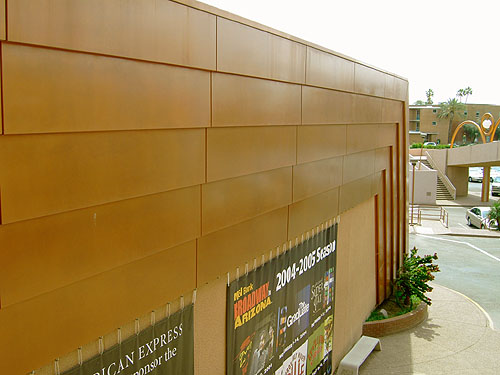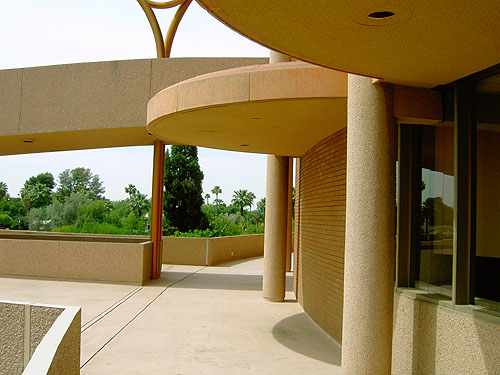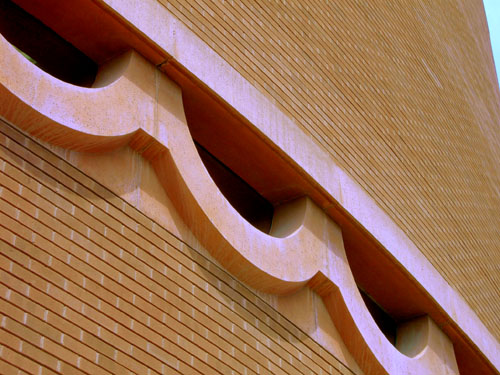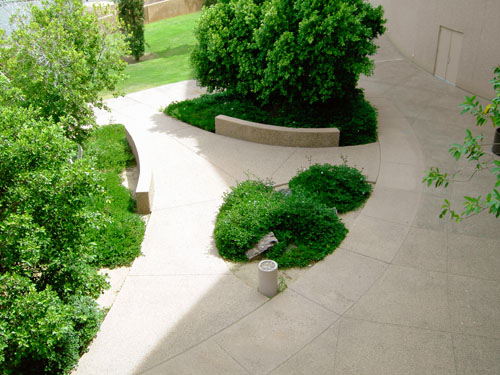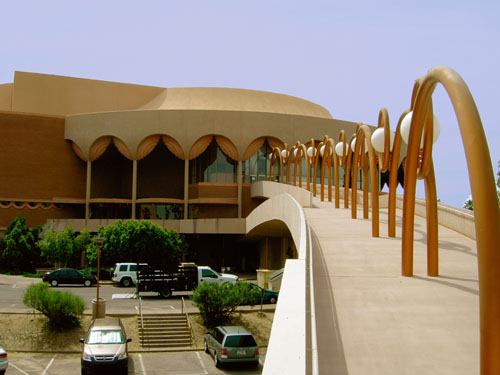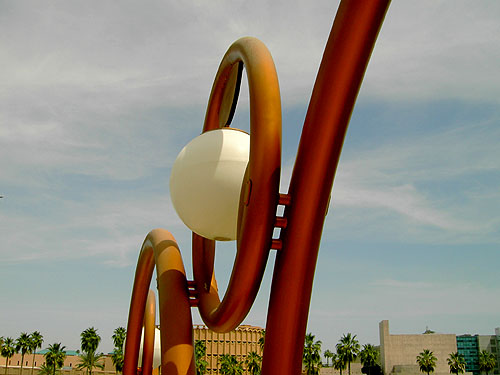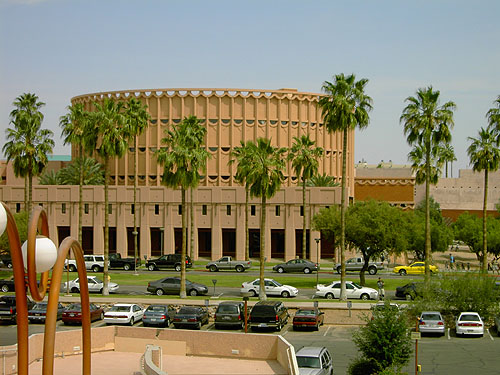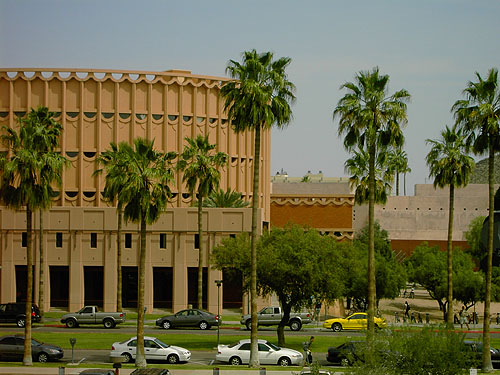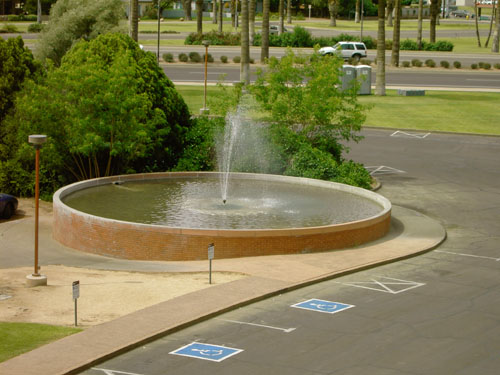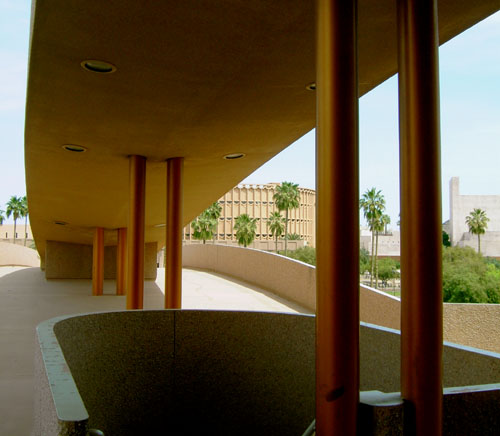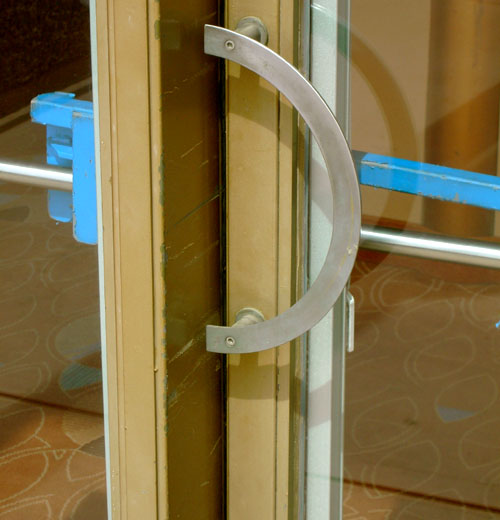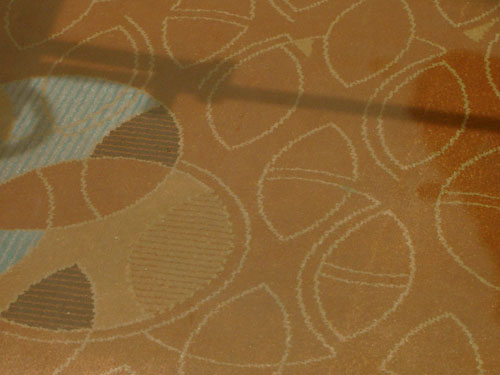
SUPPORT THE
WRIGHT LIBRARY
PROCEEDS FROM EVERY SALE GOES TO SUPPORT THE WRIGHT LIBRARY.
CLICK TO ORDER.
WE PROUDLY SUPPORT THE FRANK LLOYD WRIGHT FOUNDATION

WE PROUDLY SUPPORT THE FRANK LLOYD WRIGHT BUILDING CONSERVANCY
WE PROUDLY SUPPORT FALLINGWATER
AND THE WESTERN PENNSYLVANIA CONSERVANCY

GRADY GAMMAGE MEMORIAL AUDITORIUM (1959 - S.432) BOOKS MODELS PHOTOGRAPHS POSTCARDS GRADY GAMMAGE 2004
BOOKS
Date: 1964 Title: Grady Gammage Memorial Auditorium; Designed By Frank Lloyd Wright (Large Booklet) (Soft Cover) (Published by Arizona state University, Tempe, AZ)
Author: Edited by: Smith, Dean
Description: Descriptive booklet for the Grady Gammage Memorial Auditorium Designed By Frank Lloyd Wright. "They had walked the length and breadth of the campus that warm May afternoon in 1957, seeking a site for a university auditorium that was as yet only an improbable dream... Mr. Wright studied the grassy area in momentary silence, noting its circular frontage bounded by a busy highway, and then declared: ‘I believe this is the site. The structure should be circular in design - yes, and with outstretched arms saying "Welcome to Arizona!" ‘ ". Includes large printed envelope booklet was shipped in. (First Edition) (Sweeney 1569)
Size: 11 x 11.5
Pages: Pp 36
S#: 1569.00.0502
Date: 1964 Title: Grady Gammage Memorial Auditorium; Designed By Frank Lloyd Wright (Small Booklet)
Description: (First Edition)
Size:
Pages: Pp 5
S#: 1569.02.0401
Date: 1970 Title: Grady Gammage Memorial Auditorium Designed By Frank Lloyd Wright (Soft Cover) (Published by Arizona state University, Tempe, AZ)
Author: Edited by: Smith, Dean
Description: Revised edition of the same sized booklet produced in 1964 (S#1569). Includes some of the same sections and photographs, but completely revised and updated. "They had walked the length and breadth of the campus that warm May afternoon in 1957, seeking a site for a university auditorium that was as yet only an improbable dream... Mr. Wright studied the grassy area in momentary silence, noting its circular frontage bounded by a busy highway, and then declared: ‘I believe this is the site. The structure should be circular in design - yes, and with outstretched arms saying "Welcome to Arizona!" ‘ ". (First Edition) (Sweeney 1813)
Size: 11 x 11.5
Pages: Pp 36
S#: 1813.00.0612
Date: 2014
Title: ASU Gammage, 50 Years of Connecting Communities (Hard Cover) (Published by ON Media Publications, Tempe, AZ)
Author: Jennings- Roggensack, Colleen
Description: "This 50th anniversary commemorative book proudly highlights the first 50 years of the heart of the arts in the Valley of the Sun. The book is filled with inspiring stories, illuminating images and in-depth history of Frank Lloyd Wright's iconic masterpiece ASU Gammage. Since 1964, ASU Gammage has presented the best the arts has to offer as well as producing new works., artist residences and educational programs that foster the great artists of today and empower the artists of tomorrow. As one of the most respected arts organizations in the world, ASU Gammage through the mission of connecting communities, goes beyond the stage, venue and ASU campus to underscore the vision of a New American University with innovative programs that change lives and make a difference in our community through the shared experience of the arts." Back Cover. (First Edition)
Size: 10.25 x 10.25
Pages: Pp 108
ST#: 2014.47.0320MODELS Date: Circa 1990
Title: Grady Gammage Memorial Auditorium, Tempe, Arizona, Circa 1990 (Not Dated) (1959 - S.432).
Description: Model of the Grady Gammage Memorial Auditorium. Designed by Frank Lloyd Wright in 1959. Wright and Gammage walked the length and breadth of the campus that warm May afternoon in 1957, seeking a site for a university auditorium that was as yet only an improbable dream... Mr. Wright studied the grassy area in momentary silence, noting its circular frontage bounded by a busy highway, and then declared: "I believe this is the site. The structure should be circular in design - yes, and with outstretched arms saying 'Welcome to Arizona!' "
Label affixed to verso: “Gammage.Dedicated in 1964, Grady Gammage Memorial Auditorium, the last major work and the only public building in Arizona designed by Frank Lloyd Wright, has become the hallmark of Arizona State University. Illumined foyers, colonnades and vaulted bridges reflect the soft colors of the Arizona desert, projecting the magnificent lines of Grady Gammage Auditorium against the sky and saying to the visitor "welcome". American Historical Villages. Made in the USA. Phoenix, AZ.”
Size: 6" wide x 3.375 tall x 1.5" deep.
ST#: 1990.202.0725
PHOTOGRAPHS Date: 1959 Title: Grady Gammage Memorial Auditorium (1959 - S.432), circa 1959.
Description: Grady Gammage (left) and Frank Lloyd Wright (right) review drawing of the Auditorium. According to ASU, Wright and Gammage walked the length and breadth of the campus that warm May afternoon in 1957, seeking a site for a university auditorium that was as yet only an improbable dream... Mr. Wright studied the grassy area in momentary silence, noting its circular frontage bounded by a busy highway, and then declared: "I believe this is the site. The structure should be circular in design - yes, and with outstretched arms saying 'Welcome to Arizona!' " Frank Lloyd Wright celebrated his 90th birthday on June 8, 1957, 125 guests toasted Wright as he spoke of his commission to design the Bagdad cultural center and opera house for King Faisal in Iraq. Wright had received the commission in January 1957, and while in Santa Barbara, CA announced that he would be traveling to Iraq in May. On July 14, 1958, King Faisal was assassinate, ending the commission. Sometime after the assassination of King Faisal in July, 1958, Wright made the decision the utilize the Bagdad design for the ASU Auditorium. The Foundation dates Wright’s design of the Auditorium to 1959. After Wright’s death in April 1959, the Universities’ Board of Regency voted on April 30, 1960 to retain the Frank Lloyd Wright Foundation, under the direction of William Wesley Peters.
Size: 10 x 5.75 B&W photograph.
S#: 1377.68.0714
Date: 1963 Title: Grady Gammage Memorial Auditorium (1959 - S.432), circa 1963.
Description: Viewed from the Northeast, the auditorium is on the left, stage on the right. Steel framework is in progress. After Wright’s death in April 1959, the Universities’ Board of Regency voted on April 30, 1960 to retain the Frank Lloyd Wright Foundation, under the direction of William Wesley Peters. After the final plans and specifications were approved, the Regents called for bids and awarded the construction contract on May 19, 1962. It took 25 months to complete at a cost of $2.46 million. ASU celebrated its grand opening on September 18, 1964.
Size: 10 x 7 B&W photograph.
S#: 1565.41.0714
Date: 1963 Title: Grady Gammage Memorial Auditorium (1959 - S.432), circa 1963.
Description: Viewed from the auditorium looking down the ramp toward the East. Steel framework is in progress. The ramp splits and services the second and third levels. The arched ramp light poles intersect and support the ramp. After the final plans and specifications were approved, the Regents called for bids and awarded the construction contract on May 19, 1962. It took 25 months to complete at a cost of $2.46 million. ASU celebrated its grand opening on September 18, 1964.
Size: 10 x 7 B&W photograph.
S#: 1565.42.0714
Date: 1964
Title: Grady Gammage Memorial Auditorium 1964 (1959 - S.432).
Description: View of the Grady Gammage Memorial Auditorium from the South. Label pasted to verso: "The outer roof off of the newly dedicated Grady Gammage Memorial auditorium at Tempe, Ariz., Is supported by 50 precast concrete columns, each 55 feet high. Two pedestrian bridges (only one is visible) are linked to the main building. Each bridge has gold arcs and circles which house light fixtures. – Arizona Photographic Association, Inc." Stamped on clipping: "Oct 18 1964." Hand written on verso: "Frank Lloyd Wright – Bldgs designed by him." Stamped on verso: Please credit: Photos By Herb & Dorothy McLaughlin. Arizona Photographic Association, Inc."
Size: Original 10 x 8 B&W photograph.
S#: 1596.68.0218Date: 1964 Title: Grady Gammage Memorial Auditorium (1959 - S.432), 1964.
Description: Mrs. Wright seated in the auditorium. After Wright’s death in April 1959, the Universities’ Board of Regency voted on April 30, 1960 to retain the Frank Lloyd Wright Foundation, under the direction of William Wesley Peters. On April 20, 1961, the contract was signed. Construction began on May 23, 1962. It took 25 months to complete at a cost of $2.46 million. ASU celebrated its grand opening on September 18, 1964. It measures 300 by 250 feet by 80 feet high. The auditorium seats just over 3,000 people. Photographed during the opening ceremonies in September 1964.
Size: 8 x 10 B&W photograph.
S#: 1596.44.0716
Date: 1964
Title: 3) Gammage Memorial Auditorium.
Description: Designed in 1959, built in 1962-64. Storrer #432.
Size: 2.25 x 2.25 transparency.
S#: 1565.06.0606
(Close up)
Date: 1965
Title: Grady Gammage Memorial Auditorium 1965 (1959 - S.432).
Description: View of the Grady Gammage Memorial Auditorium from the East. Frank Lloyd Wright designed the Grady Gammage Auditorium in 1959. After Wright’s death in April 1959, the Frank Lloyd Wright Foundation, under the direction of William Wesley Peters, completed the project. Construction began on May 23, 1962. ASU celebrated its grand opening on September 18, 1964. It measures 300 by 250 feet by 80 feet high. The auditorium seats just over 3,000 people. Label pasted to verso: "Designed by the renowned Frank Lloyd Wright, the Grady Gammage Auditorium in Tempe, Ariz., is a focal point for numerous cultural events staged in the Valley of the Sun." Stamped on Verso: "Phoenix Chamber of Commerce." Note: we have a copy of this photograph stamped "Feb 12 1965" on the verso.
Size: Original 9 x 7 B&W photograph.
S#: 1846.37.0819Date: Circa 1968
Title: 1) Grady Gammage Memorial Auditorium 1968 (1959 - S.432).
Description: View of the Grady Gammage Memorial Auditorium from the East. Frank Lloyd Wright designed the Grady Gammage Auditorium in 1959. After Wright’s death in April 1959, the Frank Lloyd Wright Foundation, under the direction of William Wesley Peters, completed the project. Construction began on May 23, 1962. ASU celebrated its grand opening on September 18, 1964. Stamped on sleeve: “5. Dec 68 N6.” Printed on verso of slide: “Kodachrome Transparency.” Photographer unknown.
Size: Original 35mm Color Transparency Slide.
S#: 1757.55.0225 -1Date: Circa 1968
Title: 2) Grady Gammage Memorial Auditorium 1968 (1959 - S.432).
Description: View of the Grady Gammage Memorial Auditorium from the South. Frank Lloyd Wright designed the Grady Gammage Auditorium in 1959. After Wright’s death in April 1959, the Frank Lloyd Wright Foundation, under the direction of William Wesley Peters, completed the project. Construction began on May 23, 1962. ASU celebrated its grand opening on September 18, 1964. Stamped on sleeve: “6. Dec 68 N6.” Printed on verso of slide: “Kodachrome Transparency.” Photographer unknown.
Size: Original 35mm Color Transparency Slide.
S#: 1757.55.0225 -2Date: 1975
Title: Grady Gammage Memorial Auditorium 1975 (1959 - S.432).
Description: Viewed from the East. The smaller circular section intersects the Northeast side of the auditorium and houses the stage and classrooms. The exterior is covered in Roman brick, and is broken only by a thin row of half circular windows. In the background to the right can be seen the ASU Music Hall designed by William Wesley Peters, Taliesin Architects. Hand written on slide: "Wright, Frank Lloyd, Grady Gammage Memorial Theater, ASU, Phoenix, Beg 1960." Stamped on slide: "Nov 75." Photographed by Elizabeth H. Dull, PhD.
Size: 35mm slide and 11.5 x 8 high res color digital photograph.
S#: 1996.29.0617Date: 1975
Title: 1) Grady Gammage Memorial Auditorium, Tempe, Arizona, Circa 1975 (Not Dated) (1959 - S.432).
Description: Set of nine 35mm color slides. View of the ramp from the North. Designed by Frank Lloyd Wright in 1959. Wright and Gammage walked the length and breadth of the campus that warm May afternoon in 1957, seeking a site for a university auditorium that was as yet only an improbable dream... Mr. Wright studied the grassy area in momentary silence, noting its circular frontage bounded by a busy highway, and then declared: I believe this is the site. The structure should be circular in design - yes, and with outstretched arms saying "Welcome to Arizona!"
Text on sleeve: “Mod: Arch: AM: Wright FL: Temple, AZ: Pub: Grady Gammage Aud: Ext: Det. Ramp: Creative Con. 5/94. 066248.” Stamped on plastic sleeve: “Gepe, Sweden.”
Size: Original 35mm Color slide, sandwiched between glass, plastic mount. 8 x 10 High Res Color Digital Image.
S#: 1996.68.0725-1Date: 1975
Title: 2) Grady Gammage Memorial Auditorium, Tempe, Arizona, Circa 1975 (Not Dated) (1959 - S.432).
Description: Set of nine 35mm color slides. Viewed from the West. Designed by Frank Lloyd Wright in 1959. Wright and Gammage walked the length and breadth of the campus that warm May afternoon in 1957, seeking a site for a university auditorium that was as yet only an improbable dream... Mr. Wright studied the grassy area in momentary silence, noting its circular frontage bounded by a busy highway, and then declared: I believe this is the site. The structure should be circular in design - yes, and with outstretched arms saying "Welcome to Arizona!"
Text on sleeve: “Mod: Arch: AM: Wright FL: Temple, AZ: Pub: Grady Gammage Aud: Ext: Det. Aud&Garden: Creative Con. 9/94. 066252.” Stamped on plastic sleeve: “Gepe, Sweden.”
Size: Original 35mm Color slide, sandwiched between glass, plastic mount. 8 x 10 High Res Color Digital Image.
S#: 996.68.0725-2Date: 1975
Title: 3) Grady Gammage Memorial Auditorium, Tempe, Arizona, Circa 1975 (Not Dated) (1959 - S.432).
Description: Set of nine 35mm color slides. Detailed view of the entry columns. Designed by Frank Lloyd Wright in 1959. Wright and Gammage walked the length and breadth of the campus that warm May afternoon in 1957, seeking a site for a university auditorium that was as yet only an improbable dream... Mr. Wright studied the grassy area in momentary silence, noting its circular frontage bounded by a busy highway, and then declared: I believe this is the site. The structure should be circular in design - yes, and with outstretched arms saying "Welcome to Arizona!"
Text on sleeve: “Mod: Arch: AM: Wright FL: Temple, AZ: Pub: Grady Gammage Aud: Ext: Det. Capital: Creative Con. 8/94. 066251.” Stamped on plastic sleeve: “Gepe, Sweden.”
Size: Original 35mm Color slide, sandwiched between glass, plastic mount. 8 x 10 High Res Color Digital Image.
S#: 996.68.0725-3Date: 1975
Title: 4) Grady Gammage Memorial Auditorium, Tempe, Arizona, Circa 1975 (Not Dated) (1959 - S.432).
Description: Set of nine 35mm color slides. Viewed from the Southeast. Designed by Frank Lloyd Wright in 1959. Wright and Gammage walked the length and breadth of the campus that warm May afternoon in 1957, seeking a site for a university auditorium that was as yet only an improbable dream... Mr. Wright studied the grassy area in momentary silence, noting its circular frontage bounded by a busy highway, and then declared: I believe this is the site. The structure should be circular in design - yes, and with outstretched arms saying "Welcome to Arizona!"
Text on sleeve: “Mod: Arch: AM: Wright FL: Temple, AZ: Pub: Grady Gammage Aud: Ext: General View: Creative Con. 1/94. 066244.” Stamped on plastic sleeve: “Gepe, Sweden.”
Size: Original 35mm Color slide, sandwiched between glass, plastic mount. 8 x 10 High Res Color Digital Image.
S#: 996.68.0725-4Date: 1975
Title: 5) Grady Gammage Memorial Auditorium, Tempe, Arizona, Circa 1975 (Not Dated) (1959 - S.432).
Description: Set of nine 35mm color slides. Viewed from the Southeast. Designed by Frank Lloyd Wright in 1959. Wright and Gammage walked the length and breadth of the campus that warm May afternoon in 1957, seeking a site for a university auditorium that was as yet only an improbable dream... Mr. Wright studied the grassy area in momentary silence, noting its circular frontage bounded by a busy highway, and then declared: I believe this is the site. The structure should be circular in design - yes, and with outstretched arms saying "Welcome to Arizona!"
Text on sleeve: “Mod: Arch: AM: Wright FL: Temple, AZ: Pub: Grady Gammage Aud: Ext: Det. View F. R.: Creative Con. 6/94. 066249.” Stamped on plastic sleeve: “Gepe, Sweden.”
Size: Original 35mm Color slide, sandwiched between glass, plastic mount. 8 x 10 High Res Color Digital Image.
S#: 996.68.0725-5Date: 1975
Title: 6) Grady Gammage Memorial Auditorium, Tempe, Arizona, Circa 1975 (Not Dated) (1959 - S.432).
Description: Set of nine 35mm color slides. Viewed from the Southeast. Designed by Frank Lloyd Wright in 1959. Wright and Gammage walked the length and breadth of the campus that warm May afternoon in 1957, seeking a site for a university auditorium that was as yet only an improbable dream... Mr. Wright studied the grassy area in momentary silence, noting its circular frontage bounded by a busy highway, and then declared: I believe this is the site. The structure should be circular in design - yes, and with outstretched arms saying "Welcome to Arizona!"
Text on sleeve: “Mod: Arch: AM: Wright FL: Temple, AZ: Pub: Grady Gammage Aud: Ext: Gen. View: Creative Con. 10/94. 066253.” Stamped on plastic sleeve: “Gepe, Sweden.”
Size: Original 35mm Color slide, sandwiched between glass, plastic mount. 8 x 10 High Res Color Digital Image.
S#: 996.68.0725-6Date: 1975
Title: 7) Grady Gammage Memorial Auditorium, Tempe, Arizona, Circa 1975 (Not Dated) (1959 - S.432).
Description: Set of nine 35mm color slides. Viewed from the Southeast. Designed by Frank Lloyd Wright in 1959. Wright and Gammage walked the length and breadth of the campus that warm May afternoon in 1957, seeking a site for a university auditorium that was as yet only an improbable dream... Mr. Wright studied the grassy area in momentary silence, noting its circular frontage bounded by a busy highway, and then declared: I believe this is the site. The structure should be circular in design - yes, and with outstretched arms saying "Welcome to Arizona!"
Text on sleeve: “Mod: Arch: AM: Wright FL: Temple, AZ: Pub: Grady Gammage Aud: Ext: Gen. View: Creative Con. 7/94. 066250.” Stamped on plastic sleeve: “Gepe, Sweden.”
Size: Original 35mm Color slide, sandwiched between glass, plastic mount. 8 x 10 High Res Color Digital Image.
S#: 996.68.0725-7Date: 1975
Title: 8) Grady Gammage Memorial Auditorium, Tempe, Arizona, Circa 1975 (Not Dated) (1959 - S.432).
Description: Set of nine 35mm color slides. Viewed from the Southeast. Designed by Frank Lloyd Wright in 1959. Wright and Gammage walked the length and breadth of the campus that warm May afternoon in 1957, seeking a site for a university auditorium that was as yet only an improbable dream... Mr. Wright studied the grassy area in momentary silence, noting its circular frontage bounded by a busy highway, and then declared: I believe this is the site. The structure should be circular in design - yes, and with outstretched arms saying "Welcome to Arizona!"
Text on sleeve: “Mod: Arch: AM: Wright FL: Temple, AZ: Pub: Grady Gammage Aud: Ext: Det. Ramp: Creative Con. 2/94. 066245.” Stamped on plastic sleeve: “Gepe, Sweden.”
Size: Original 35mm Color slide, sandwiched between glass, plastic mount. 8 x 10 High Res Color Digital Image.
S#: 996.68.0725-8Date: 1975
Title: 9) Grady Gammage Memorial Auditorium, Tempe, Arizona, Circa 1975 (Not Dated) (1959 - S.432).
Description: Set of nine 35mm color slides. Viewed from the East. Designed by Frank Lloyd Wright in 1959. Wright and Gammage walked the length and breadth of the campus that warm May afternoon in 1957, seeking a site for a university auditorium that was as yet only an improbable dream... Mr. Wright studied the grassy area in momentary silence, noting its circular frontage bounded by a busy highway, and then declared: I believe this is the site. The structure should be circular in design - yes, and with outstretched arms saying "Welcome to Arizona!"
Text on sleeve: “Mod: Arch: AM: Wright FL: Temple, AZ: Pub: Grady Gammage Aud: Ext: Det: Creative Con. 3/94. 066246eeee.” Stamped on plastic sleeve: “Gepe, Sweden.”
Size: Original 35mm Color slide, sandwiched between glass, plastic mount. 8 x 10 High Res Color Digital Image.
S#: 996.68.0725-9Date: 1975
Title: 1) Grady Gammage Memorial Auditorium, Tempe, Arizona, Circa 1975 (Not Dated (1959 - S.432).
Description: Set of three 35mm color slides. Viewed from the Southeast. Frank Lloyd Wright designed the Grady Gammage Auditorium in 1959. After Wright’s death in April 1959, the Frank Lloyd Wright Foundation, under the direction of William Wesley Peters, completed the project. Construction began on May 23, 1962. ASU celebrated its grand opening on September 18, 1964. Text on sleeve: “Mod: Arch: AM: Wright FL: Temple, AZ: Ed: U. Of Arizona: Grady Gammage Auditorium: Ext. 1964. Kaidib AH157/88. 039379.” (Note: Color was so unbalanced we converted this image to B&W.) Stamped on plastic sleeve: “Gepe, Sweden.”
Size: Original 35mm Color slide, sandwiched between glass, plastic mount. 8 x 10 High Res Color Digital Image.
S#: 1996.69-0725-1Date: 1975
Title: 2) Grady Gammage Memorial Auditorium, Tempe, Arizona, Circa 1975 (Not Dated (1959 - S.432).
Description: Set of three 35mm color slides. Detailed view of the columns. Frank Lloyd Wright designed the Grady Gammage Auditorium in 1959. After Wright’s death in April 1959, the Frank Lloyd Wright Foundation, under the direction of William Wesley Peters, completed the project. Construction began on May 23, 1962. ASU celebrated its grand opening on September 18, 1964. Text on sleeve: “Mod: Arch: AM: Wright FL: Temple, AZ: Ed: U. Of Arizona: Grady Gammage Auditorium (D): Ext. 1964. Kaidib AH159/88. 039381 (D). Holy Cross.” (Note: Color was so unbalanced we converted this image to B&W.) Stamped on plastic sleeve: “Gepe, Sweden.”
Size: Original 35mm Color slide, sandwiched between glass, plastic mount. 8 x 10 High Res Color Digital Image.
S#: 1996.69-0725-2Date: 1975
Title: 3) Grady Gammage Memorial Auditorium, Tempe, Arizona, Circa 1975 (Not Dated (1959 - S.432).
Description: Set of three 35mm color slides. Detailed view of the ramp. Frank Lloyd Wright designed the Grady Gammage Auditorium in 1959. After Wright’s death in April 1959, the Frank Lloyd Wright Foundation, under the direction of William Wesley Peters, completed the project. Construction began on May 23, 1962. ASU celebrated its grand opening on September 18, 1964. Text on sleeve: “Mod: Arch: AM: Wright FL: Temple, AZ: Ed: U. Of Arizona: Grady Gammage Auditorium: Ext: Exit Pathway. 1964. Kaidib AH158/88. 039380. Holy Cross.” (Note: Color was so unbalanced we converted this image to B&W.) Stamped on plastic sleeve: “Gepe, Sweden.”
Size: Original 35mm Color slide, sandwiched between glass, plastic mount. 8 x 10 High Res Color Digital Image.
S#: 1996.69-0725-3Date: 1975
Title: ASU Music Hall designed by Wesley Peters, Taliesin Architects.
Description: Constructed in 1970, the building has eight levels, three of which are underground. William Wesley Peters, Frank Lloyd Wright's son-in-law, designed the building. Hand written on slide: "Taliesin Associated Architects, ASU, Phoenix, 1972." Photographed by Elizabeth H. Dull, PhD.
Size: 35mm slide and 11.5 x 8 high res color digital photograph.
S#: 1996.30.0617Date: 1985
Title: 1) Grady Gammage Memorial Auditorium, Tempe, Arizona, Circa 1985 (Not Dated) (1959 - S.432).
Description: Set of four 35mm color slides. Viewed from the South. Frank Lloyd Wright designed the Grady Gammage Auditorium in 1959. The Grady Gammage Auditorium is a renowned venue known for its architectural brilliance and cultural significance. The circular design, featuring two long ramps that resemble outstretched arms, is the final non-residential architectural masterpiece by Frank Lloyd Wright. After Wright’s death in April 1959, the Frank Lloyd Wright Foundation, under the direction of William Wesley Peters, completed the project. Construction began on May 23, 1962. ASU celebrated its grand opening on September 18, 1964.
Text on sleeve: “Mod: Arch: AM: Wright FL: Temple, AZ: Ed: Arizona State U. Grady Gammage Mem. Auditorium: From South: 1959. Radford 94US-177/96. 071048. Holy Cross.” Stamped on plastic sleeve: “Gepe, Sweden.”
Size: Original 35mm Color slide, sandwiched between glass, plastic mount. 8 x 10 High Res Color Digital Image.
ST#: 1985.90.0725-1Date: 1985
Title: 2) Grady Gammage Memorial Auditorium, Tempe, Arizona, Circa 1985 (Not Dated) (1959 - S.432).
Description: Set of four 35mm color slides. Viewed from the Southeast. Frank Lloyd Wright designed the Grady Gammage Auditorium in 1959. The Grady Gammage Auditorium is a renowned venue known for its architectural brilliance and cultural significance. The circular design, featuring two long ramps that resemble outstretched arms, is the final non-residential architectural masterpiece by Frank Lloyd Wright. After Wright’s death in April 1959, the Frank Lloyd Wright Foundation, under the direction of William Wesley Peters, completed the project. Construction began on May 23, 1962. ASU celebrated its grand opening on September 18, 1964.
Text on sleeve: “Mod: Arch: AM: Wright FL: Temple, AZ: Ed: Arizona State U. Grady Gammage Mem. Auditorium: From Southeast: 1959. Radford 94US-178. 071068. Holy Cross.” Stamped on plastic sleeve: “Gepe, Sweden.”
Size: Original 35mm Color slide, sandwiched between glass, plastic mount. 8 x 10 High Res Color Digital Image.
ST#: 1985.90.0725-2Date: 1985
Title: 3) Grady Gammage Memorial Auditorium, Tempe, Arizona, Circa 1985 (Not Dated) (1959 - S.432).
Description: Set of four 35mm color slides. Detailed view of the column. Frank Lloyd Wright designed the Grady Gammage Auditorium in 1959. The Grady Gammage Auditorium is a renowned venue known for its architectural brilliance and cultural significance. The circular design, featuring two long ramps that resemble outstretched arms, is the final non-residential architectural masterpiece by Frank Lloyd Wright. After Wright’s death in April 1959, the Frank Lloyd Wright Foundation, under the direction of William Wesley Peters, completed the project. Construction began on May 23, 1962. ASU celebrated its grand opening on September 18, 1964.
Text on sleeve: “Mod: Arch: AM: Wright FL: Temple, AZ: Ed: Arizona State U. Grady Gammage Mem. Auditorium: Column Capital: 1959. Radford 94US-182/96 071087. Holy Cross.” Stamped on plastic sleeve: “Gepe, Sweden.”
Size: Original 35mm Color slide, sandwiched between glass, plastic mount. 8 x 10 High Res Color Digital Image.
ST#: 1985.90.0725-3Date: 1985
Title: 4) Grady Gammage Memorial Auditorium, Tempe, Arizona, Circa 1985 (Not Dated) (1959 - S.432).
Description: Set of four 35mm color slides. Viewed from the East. Frank Lloyd Wright designed the Grady Gammage Auditorium in 1959. The Grady Gammage Auditorium is a renowned venue known for its architectural brilliance and cultural significance. The circular design, featuring two long ramps that resemble outstretched arms, is the final non-residential architectural masterpiece by Frank Lloyd Wright. After Wright’s death in April 1959, the Frank Lloyd Wright Foundation, under the direction of William Wesley Peters, completed the project. Construction began on May 23, 1962. ASU celebrated its grand opening on September 18, 1964.
Text on sleeve: “Mod: Arch: AM: Wright FL: Temple, AZ: Ed: Arizona State U. Grady Gammage Mem. Auditorium: Ramped Bridge: 1959. Radford 94US-186/96 071069. Holy Cross.”
Size: Original 35mm Color slide, sandwiched between glass, plastic mount. 8 x 10 High Res Color Digital Image.
ST#: 1985.90.0725-4Date: 2004
Title: Grady Gammage Memorial Auditorium, Tempe, Arizona, 2004 (1959 - S.432).
Description: Set of 31 photographs of the Grady Gammage Memorial Auditorium. A Symphony for the Eyes. As Frank Lloyd Wright celebrated his 90th birthday on June 8, 1957, 125 guests toasted Wright as he spoke of his commission to design the Bagdad cultural center and opera house for King Faisal in Iraq. Wright had received the commission in January 1957, and while in Santa Barbara, CA announced that he would be traveling to Iraq in May. On July 14, 1958, King Faisal was assassinate, ending the commission. According to ASU, Wright and Gammage walked the length and breadth of the campus that warm May afternoon in 1957, seeking a site for a university auditorium that was as yet only an improbable dream... Mr. Wright studied the grassy area in momentary silence, noting its circular frontage bounded by a busy highway, and then declared: "I believe this is the site... Continue...
Size: Original 8 x 10 High Res digital image.
ST#: 2004.39.0714 (1-31)
See Additional Photographs...
See Additional Photographs...Date: 2004 Title: 3) Gammage Memorial Auditorium.
Description: Designed in 1959, built in 1962-64. Storrer #432.
Size:
ST#: 2004.21.0606
Date: 1964 Title: 4) Gammage Memorial Auditorium.
Description: Designed in 1959, built in 1962-64. Storrer #432.
Size: 2.25 x 2.25 transparency.
S#: 1565.07.0606
Date: 2004 Title: 4) Gammage Memorial Auditorium.
Description: Designed in 1959, built in 1962-64. Storrer #432.
Size:
ST#: 2004.22.0606
POSTCARDS Date: Circa 1964 Title: Grady Gammage Memorial Auditorium
Description: "Grady Gammage Memorial Auditorium. Arizona State University, Tempe, Arizona. The last large design of Frank Lloyd Wright produced a fine arts center which commands notice from the world. Completely circular in design, with two-level pedestrian bridges extending two hundred feet from either side, this magnificent view illustrates the success of the designer’s hope that the structure would seem to say ‘Welcome to Arizona’." "Color Photo by Bob Petley." Pub. And Distributed by Petley Studios, Phoenix, Arizona. #PH-3. (Constructed between 1962-1964, and opened in 1964 the building is named for Dr. Grady Gammage.)
Size: 5.5 x 3.5.
S#: 1596.16.0110
Date: 1965 Title: Grady Gammage Memorial Auditorium
Description: “Grady Gammage Memorial Auditorium. Last large design of Frank Lloyd Wright. Arizona State University, Tempe, Arizona is the proud home of this most imposing and fascinating piece of construction in the State of Arizona. The auditorium seats 3000 in long, wide-spaced arcs of seats unbroken by aisles, and provides excellent acoustics conditions throughout. It will serve the university and community as concert hall, opera, and drama theater.” “Agfachrome Photo by Bob Petley.” Pub. by Petley Studios, 4051 E. Van Buren, Phoenix, Arizona. #79498. (Constructed between 1962-1964, and opened in 1964 the building is named for Dr. Grady Gammage.)
Size: 5.3 x 3.5.
S#: 1596.13.1208
Date: Circa 1965
Title: Frank Lloyd Wright, Grady Gammage Auditorium Circa 1965.
Description: Real Photo Postcard of Frank Lloyd Wright and the Grady Gammage Memorial Auditorium at the Arizona State University at Tempe. The Grady Gammage Memorial Auditorium was designed by Frank Lloyd Wright in 1959 before his death. Opening ceremonies took place in September 1964. Text on face: "Frank Lloyd Wright, Spring Green, W8sconsin. The Grady Gammage Memorial Auditorium on the campus of Arizona State University at Tempe. It was designed by the late Famous architect Frank Lloyd Wright. The illustration of Wright is from a stamp produced in 1962. Text on verso: "Photo Post Card (top). Address (right). There is an uncanceled 2 cent Frank Lloyd Wright stamp affixed to the top right corner.
Size: 5.5 x 3.5.
S#: 1628.102.0921Date: Circa 1966 Title: Grady Gammage Memorial Auditorium
Description: “Grady Gammage Memorial Auditorium. Arizona State University, Tempe, Arizona. The last large design of Frank Lloyd Wright produced a fine arts center which commands notice from the world. Completely circular in design, with two-level pedestrian bridges extending two hundred feet from either side, this magnificent view illustrates the success of the designer’s hope that the structure would seem to say ‘Welcome to Arizona’.” ASU Photograph by John Pilch. (Pilch, Richard R. 1967-1996, Physical Education Faculty) Published by Petley Studios, 4051 E. Van Buren, Phoenix, Arizona. #79905. (Published late 60's) (Constructed in 1964, the building is named for Dr. Grady Gammage.) (Note: Have verified a P.M. dated Feb. 1966.)
Size: 5.5 x 3.5
S#: 1846.05.0207
Date: Circa 1971 Title: Grady Gammage Memorial Auditorium Aerial
Description: Front: "Arizona State University, Tempe, Arizona". Back: "Arizona State University, Tempe, Arizona. Aerial view of Tempe and the Arizona State University Campus. The beautiful Grady Gammage Memorial Auditorium, designed by Frank Lloyd Wright, is in the center of the view. To the right of "A" Mountain in the background is the Sundevil Stadium packed with football fans, watching the post season ‘Fiesta Bowl’ game. Aerial photo by Bob Petley." Published by Petley Studios, 4051 E. Van Buren, Phoenix, Arizona. #P301519. Plastichrome(R) (Constructed between 1962-1964, and opened in 1964 the building is named for Dr. Grady Gammage.) (The Fiesta Bowl was first played at the Sundevil Stadium in 1971 and continued there until 2006. ASU played in five of the first seven Fiesta Bowls. The round ASU Music Building (to the left of the Auditorium) was designed by the Frank Lloyd Wright Foundation and completed in 1971.)
Size: 6 x 4
S#: 1867.06.0410
GRADY GAMMAGE MEMORIAL AUDITORIUM 2004
Set of 31 photographs 2004, Grady Gammage Memorial Auditorium (1959 - S.432). A Symphony for the Eyes. As Frank Lloyd Wright celebrated his 90th birthday on June 8, 1957, 125 guests toasted Wright as he spoke of his commission to design the Bagdad cultural center and opera house for King Faisal in Iraq. Wright had received the commission in January 1957, and while in Santa Barbara, CA announced that he would be traveling to Iraq in May. On July 14, 1958, King Faisal was assassinate, ending the commission. According to ASU, Wright and Gammage walked the length and breadth of the campus that warm May afternoon in 1957, seeking a site for a university auditorium that was as yet only an improbable dream... Mr. Wright studied the grassy area in momentary silence, noting its circular frontage bounded by a busy highway, and then declared: "I believe this is the site. The structure should be circular in design - yes, and with outstretched arms saying 'Welcome to Arizona!' " The Foundation dates Wright’s design of the Auditorium to 1959. After Wright’s death in April 1959, the Universities’ Board of Regency voted on April 30, 1960 to retain the Frank Lloyd Wright Foundation, under the direction of William Wesley Peters. On April 20, 1961, the contract was signed. Construction began on May 23, 1962. It took 25 months to complete at a cost of $2.46 million. ASU celebrated its grand opening on September 18, 1964. It measures 300 by 250 feet by 80 feet high. Fifty concrete columns support the round roof. Twin ramps extending 200 feet from the north and east sides. The auditorium seats just over 3,000 people. This set of 31 images was photograph on April 26, 2004 by Douglas M. Steiner.
20) Grady Gammage Memorial Auditorium (1959 - S.432) 2004. View from the North. Detail of the second level balcony. The ramp splits and services the second and third levels. Arched ramp lights intersect and support the ramp. Circular cantilevered roofs cover the second level balcony. (ST#2004.39.0714-20)
21) Grady Gammage Memorial Auditorium (1959 - S.432) 2004. Detail of the smaller circular section that intersects the Northeast side of the auditorium and houses the stage and classrooms. The exterior is covered in Roman brick, and is broken only by a thin row of half circular windows. (ST#2004.39.0714-21) 22) Grady Gammage Memorial Auditorium (1959 - S.432) 2004. Service ramp walls flow into circular piers. Sidewalk ends are circular. (ST#2004.39.0714-22)
23) Grady Gammage Memorial Auditorium (1959 - S.432) 2004. Sidewalks and plantings flow with the building. (ST#2004.39.0714-23)
24) Grady Gammage Memorial Auditorium (1959 - S.432) 2004. The Northern ramp mimics the Eastern. The ramp extending out 200 feet from the auditorium. 10 arched circular beams are joined at the top by a separate circular beam, each with a circular lamp. The arched ramp lights intersect and support the ramp. The ramp splits and services the second and third levels. (ST#2004.39.0714-24)
25) Grady Gammage Memorial Auditorium (1959 - S.432) 2004. Detail of the arched ramp lights. The School of Music building, designed by William Wesley Peters and the Taliesin Architects, can be seen in the background. (ST#2004.39.0714-25)
26) The School of Music building was designed by William Wesley Peters and the Taliesin Architects. Viewed from the South. The design mimics many of the elements of the Grady Gammage Auditorium. (ST#2004.39.0714-26)
27) The School of Music building was designed by William Wesley Peters and the Taliesin Architects. Viewed from the South. The design mimics many of the elements of the Grady Gammage Auditorium. (ST#2004.39.0714-27)
28) Grady Gammage Memorial Auditorium (1959 - S.432) 2004. Western fountain viewed from the ramp. (ST#2004.39.0714-28)
29) Grady Gammage Memorial Auditorium (1959 - S.432) 2004. View of the ramp from the second level, looking North. The ramp splits and services the second and third levels. The arched ramp light poles intersect and support the ramp. Stairs lead to the lower level. (ST#2004.39.0714-29)
30) Grady Gammage Memorial Auditorium (1959 - S.432) 2004. Door handles are formed by half circles. (ST#2004.39.0714-30)
31) Grady Gammage Memorial Auditorium (1959 - S.432) 2004. View of the interior carpet. Originally an plain orange/gold carpet, it was replaced with a carpet designed by Frank Lloyd Wright, first produced in 1955 by Schumacher, design Number 104. (ST#2004.39.0714-31)
Text and photographs copyright 2014, Douglas M. Steiner
HOME ARTIFACTS AUDIO BOOKS PERIODICALS PHOTOS POSTCARDS POSTERS STAMPS STUDIES ASSISTING ABOUT SLIDE SHOW To donate or pass on information, comments or questions:
steinerag@msn.com
©Copyright Douglas M. Steiner, 2001, 2025
